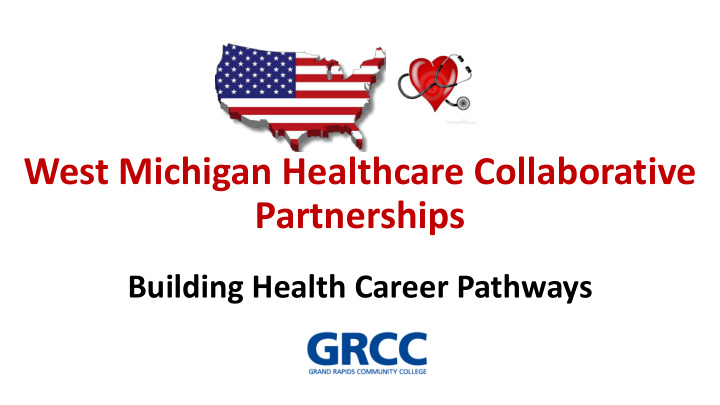



West Michigan Healthcare Collaborative Partnerships Building Health Career Pathways
West Michigan n – Grand Rapids • 1,027,703 population, greater Grand Rapids Area • Home of some major employers: Steelcase, Herman Miller, Haworth, Amway, Meijer, Axios, Perrigo. • Largest employer – Spectrum Health, • Mercy Health (Trinity Health – 4 th biggest employer • Three hospital systems: Spectrum, Mercy, Metro/U of MI in Grand Rapids, 4 other hospitals (not counting mental health) • Close to 55 long term care employers in our region
A A sea of change in health thcare!? • Affordable care act. • Retirements • Aging Population • Reduction in the number of people in our state after the “great recession”. • The demographics of our community were changing. • What was the healthcare sector to do?
Could our community college be a factor in a sector of education that deals with strict accreditation requirements? Quickly We might have to do this differently. • Our principles: • GRCC’s program must be of the highest quality • Employers must be engaged in the creation, content, clinical placements, feedback loop • Program occupations must pay a living wage jobs
Partnership p & Collaboration • Working with our USDOL Career One- stop: West Michigan Works! • Getting the right people from healthcare employer organizations together to review occupational data. • Coffee “breaks” • Role of the community non-profits. • How are we going to pay for this?
What is the America’s Promise Grant America’s Promise grants are designed to accelerate the development and expansion of regional workforce partnerships committed to providing a pipeline of skilled workers in specific sectors. Each grant requires a partnership that includes industry leaders, senior level leadership from workforce and economic development organizations, education institutions, elected officials, and other important community stakeholders. Grantees will focus on in-demand industries such as information technology, healthcare, advanced manufacturing, financial services and educational services. 11/17/2016 US Department of Labor
• Awarded to 23 regional • Funded by H-1B temporary visa partnerships in 28 states program. • 21,000 Americans to education • Create best strategies to and in-demand jobs. successfully move participants into middle-skill jobs or higher • Tuition free or low cost tuition skilled jobs. opportunities. • Healthcare focus in west • Employer involvement in design Michigan – Work of the Health and delivery of education and Innovation Council training • Create at least 4 career • Evidence-based sector strategies pathways so individuals to increase college completion, understand healthcare career employability, employment opportunities. earnings & outcomes of job seekers.
Initi tial Gr Grant P t Partn tner ers Hispanic Center of Western Michigan CLARK
Long Term rm Care – Certified N Nursing As Assistant • College had no healthcare lab space available • Four other C.N.A. training centers in the region. (State required 70 hr program) • C.N.A. wages seemed pretty low $10- 11/hr. • Brought a group of employers together. • Feedback from our neighborhood organizations.
• Holland Home, stepped forward and built a C.N.A. training lab for GRCC at no cost to GRCC. • Sunset Hills, Holland Home and Clark all worked to find qualified instructors. • Employers wrote to the State of Michigan to get approvals for GRCC program moved quicker • Employer guaranteed a $13/hr starting pay for GRCC graduates
C.N.A. . Program R Results ts? • Discussions regarding C.N.A. • First cohort – 50% did not pass started in November 2016. the State (Prometric test). Retooled, Remediated. • Awarded grant January 2017. • Second go round – all passed. • New Lab was ready by March, 2017 • Next two cohorts: 95% passed. • First cohort began in April 2017 • 100% hired • Three cohorts have completed as of August 2017. 32 individuals. • One integrated English as a Second Language/C.N.A. cohort
Medical A Assistants ts • Employer group wants a medical assistant program different from what exists in the community. • Accelerated, non-credit model built. (Articulates to 30 credits) (Higher Learning Commission, Financial Aid rules, Faculty union contract issues). How would we attract individuals to this program that met the demographics our employers were looking for?
Medical A Assistants ts • How would our medical assistants be skilled up to work in an office that involved more technology, health “teams” working with patients? • How could our students afford to take this program? APPRENTICESHIP IDEA • Willingness of Mercy Health and Spectrum Health to try this. • CAAHEP accreditation work. • Creation of the career portfolio system
Results ts • The 6 cohorts of the program we had before apprenticeship started had less than 3% diverse students. • Now open enrollment program has 21% diverse students • First cohort of apprenticeship, only one person of color. • Second cohort of apprenticeship 18% people of color. • Third cohort – 432 applicants. 43% diverse
Create a robust pipeline of competent , diverse and compassionate health care workers to meet the needs of the region for the next 15 years.
What do YO YOU in Maryland need to do to make this happen? • Talk to each other and really listen. • Community Colleges – the role you know and can grow. • PARTNER, PARTNER, PARTNER • Support each other and tell each other what you need. • What did GRCC need: Cover cost of programming, labs, student support, clinical placement. Wrap-around services for our students. • Form a plan. If you have a good plan things will happen.
Join Us…….. Hispanic Center of Western Michigan CLARK
Thank you and good luck! Contact Information: Julie Parks jparks@grcc.edu 616.234.3714
Recommend
More recommend